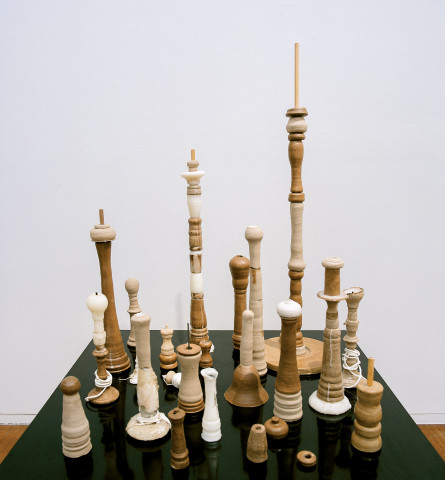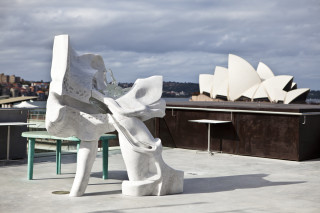One of the key characteristics of the art of Hany Armanious is its playful logic of analogy. This includes analogies based upon likeness or resemblance of material, form, function, process as well as linguistic analogy—puns, homonyms, rhymes, anagrams and other forms of word play. Armanious treats materials and words as equally malleable things. This is the poetic and procreative logic of the work and is what sets it in motion.
Exhibition Dates: 1 July – 24 July 2004
One of the key characteristics of the art of Hany Armanious is its playful logic of analogy. This includes analogies based upon likeness or resemblance of material, form, function, process as well as linguistic analogy—puns, homonyms, rhymes, anagrams and other forms of word play. Armanious treats materials and words as equally malleable things. This is the poetic and procreative logic of the work and is what sets it in motion. Another key characteristic is the way Armanious invests obliquely in various brands of mystical practice: alchemy, shamanism, fortune-telling as well as other paranormal phenomena, cults and the occult. As with his use of analogy, these irrational principles are revelational. Armanious uses them as vehicles to navigate beyond the expectation of reason in order to arrive at things not normally seen. The current exhibition at Roslyn Oxley9 Gallery consists of three sculptural groups which together offer a basic lesson in Armanious logic:
Forging the Energy Body (Swegypt)
In the largest work in the exhibition, Armanious transports the ‘cult of casting’, into which he first delved with his various Snake Oil works of the 1990s and which he took to its extreme elaboration in his installation Selflok (1994–2003). Now casting enters the ominous world of metallurgy. All of the objects in Forging the Energy Body (Swegypt) are arranged like a still life on a shelving unit and are bells or parts of bells or the moulds from which bells were cast or they are horn speakers all cast in pewter or aluminium. The origin of this work is the sound element, a recording of seven ABBA songs played with synthesized Arabic instruments which Armanious has called ARABBA. In Swegypt, an exhibition at Artspace Sydney in 2003, Armanious broadcast this same music from horn speakers placed at the corners of a large ‘sheik’s’ tent. The speakers reappear now as gnarled and elemental cast forms and relate analogically to the similarly flanging shapes of the bells – another family of sound-making objects.
The forms—bells—are magical things in their own right, employed in shamanistic rituals, and the material—pewter—has a connection to fortune telling in the northern European practice of casting molten pewter into water at New Year’s Eve and reading the resulting form like tea leaves in order to learn what the coming year holds. Pewter is also a classic material of trinkets and lucky charms. But, importantly, bells present Armanious with a basic problem of casting: the clapper which makes the bell sound is lost in the casting process—i.e. to cast the interior of the bell form is to lose the very thing that gives the bell its percussive power. So the clappers are removed and exhibited separately and the bells are rendered mute. Continuing the chain of reasoning, Armanious finds a similar formal dilemma in the domestic task of filling a pepper grinder with peppercorns. The spindle of the pepper grinder gets in the way, prohibiting nearly the very process that lets the mill function as a tool. This problem is illustrated by Armanious in the short video loop displayed on a small monitor installed on the lower shelf of Forging the Energy Body (Swegypt)’s shelving unit.
Finding the Assemblage Point (Clay Pipes from ARABBA)
The second group is arranged on a low table. These objects are all made or appear to be made through the process of spinning, either turned on a potter’s wheel or a lathe like a pepper grinder. The bulbous forms of the process of turning are common to both pepper grinders, lamp stands, light bulbs and Arabic instruments. Armanious presents these things together in various heights but foils our expectation of process by casting some of them in wax with wicks as fully functioning candles. Form and function are conflated but what one expects to have been an exercise in wood turning has been claimed by the process—the cult—of casting. And again the problem of the spindle appears having now assumed the form of a candle wick.
Scaring Away the Human Form (Death as Adviser)
The third group appears like some ancient landscape and represents the most primitive casting exercise. In Scaring Away the Human Form (Death as Adviser), Armanious brings us back to the basic material and seed. This work is made almost entirely from black peppercorns. Large hard primordial forms rise out of a field of peppercorns. The forms are made of two-part polyurethane cast into great sacks of peppercorns. In the process of casting Armanious increased incrementally the viscosity of the polyurethane mix so that the binding polymer reached further into the peppercorn matrix with each cast. The result is a group of pinnacles or volcanic sill-like structures which illustrate at its most basic level the casting process with which Armanious is obsessed: the exploration of a cavity by a viscous substance. In the case of the peppercorns, the cavity did not exist prior to the introduction of the casting medium which permits the discovery, retrieval and revelation of a form that could not otherwise have been known.
—Amanda Rowell
—
Hany Armanious has exhibited extensively in Australia and overseas. In 2001 his major installation work, Selflok, was shown as a solo exhibition at the UCLA Hammer Museum in Los Angeles and at the Ian Potter Museum, Melbourne in 2002. In 1993 he was selected for the Aperto section of the VeniceBiennale. Other international exhibitions have included the 1992 Biennale of Sydney, 1995 Johannesburg Biennale and in 2003 Armanious was included in an international group exhibition, Bloom: Mutation, Toxicity and the Sublime, at Govett-Brewster Gallery in New Plymouth, curated by Gregory Burke. In 1998, Armanious won the prestigious Moet and Chandon Fellowship with his Untitled Snake Oil, a group of inverted wine glasses and coloured Hot melt molds. His works are held in many major public collections in Australiaand overseas. The current exhibition was developed during a six week residency at Elam School of Fine Art in Auckland and the works will be included in Armanious’ solo exhibition at Auckland Art Gallery in December 2004. The ARABBA cd will be launched at the opening of the Auckland exhibition. The Cult is Hany Armanious’ second exhibition with Roslyn Oxley9 Gallery. Hany would like to thank the staff at Elamfor their support for the project.

pewter, chromed aluminium, plaster, adhesive stickers, brass, LCD monitor, spray enamel and silver marker on form-ply and steel one-off video, filmed on digital camera, screening format DVD, 30 second loop with original ARABBAA music
154 x 117 x 90 cm

clay, wax, cotton, acrylic varnish, dowel and steel on form-ply and steel
155 x 100 x 90 cm
 Group Show, Caught Stealing
Group Show, Caught Stealing
National Art School, Sydney, 2019
 Group Show, The Like Button
Group Show, The Like Button
Roslyn Oxley9 Gallery, 2018-19
 Hany Armanious
Hany Armanious
Roslyn Oxley9 Gallery, 2018
 Group Show, State of Play
Group Show, State of Play
Roslyn Oxley9 Gallery, 2017
 Group Show, Future Eaters
Group Show, Future Eaters
Monash University Museum of Art, Melbourne, 2017
 Hany Armanious Cavities, Platforms, Footings: Selected Work 2007 - 2012
Hany Armanious Cavities, Platforms, Footings: Selected Work 2007 - 2012
Roslyn Oxley9 Gallery, 2016
 Hany Armanious
Hany Armanious
Roslyn Oxley9 Gallery, 2015
 Hany Armanious we go out inside
Hany Armanious we go out inside
Roslyn Oxley9 Gallery, 2013
 Hany Armanious Fountain
Hany Armanious Fountain
Museum of Contemporary Art Sculpture Terrace Commission, Sydney, 2012
Hany Armanious The Golden Thread
Monash University Museum of Art, Melbourne, 2012
 Hany Armanious The Golden Thread
Hany Armanious The Golden Thread
54th Venice Biennale, 2011
Hany Armanious Lines of Communication
Vodaphone Hutchison Australia, Sydney, 2010
 Hany Armanious Uncanny Valley
Hany Armanious Uncanny Valley
Roslyn Oxley9 Gallery, 2009
 Group Show, Lucky Town
Group Show, Lucky Town
Roslyn Oxley9 Gallery, 2008-09
Hany Armanious The Oracle
Contemporary Art Museum, St Louis, 2008
 Group Show, Summer '07 '08
Group Show, Summer '07 '08
Roslyn Oxley9 Gallery, 2007
 Group Show, STOLEN RITUAL
Group Show, STOLEN RITUAL
Roslyn Oxley9 Gallery, 2006-07
 Hany Armanious Intelligent Design
Hany Armanious Intelligent Design
Roslyn Oxley9 Gallery, 2006
Hany Armanious National Sculpture Prize
National Gallery of Australia, Canberra, 2005
 Group Show
Group Show
Roslyn Oxley9 Gallery, 2005
 Hany Armanious The Cult
Hany Armanious The Cult
Roslyn Oxley9 Gallery, 2004
 Hany Armanious Art Nouveau Barbeque
Hany Armanious Art Nouveau Barbeque
Roslyn Oxley9 Gallery, 2003
Hany Armanious Selflok
Brewster Art Gallery, New Plymouth, New Zealand, 2001


